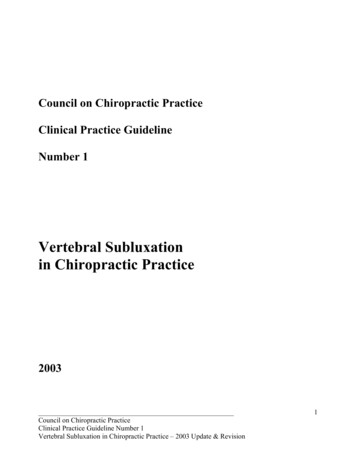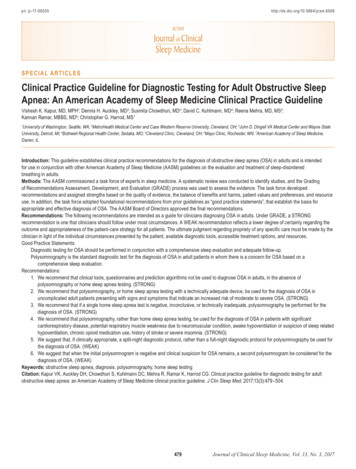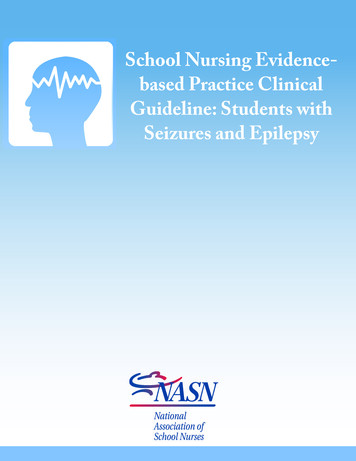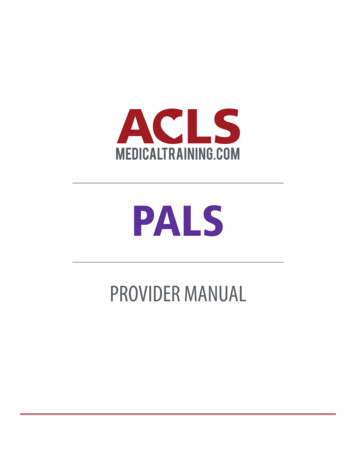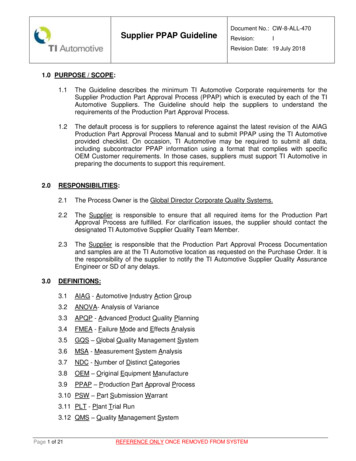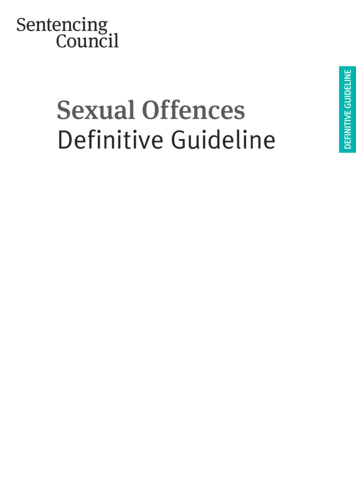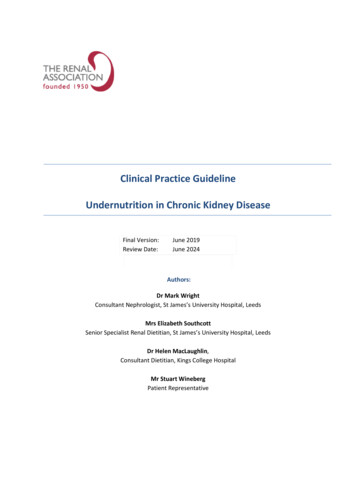
Transcription
Clinical Practice GuidelineUndernutrition in Chronic Kidney DiseaseFinal Version:Review Date:June 2019June 2024Authors:Dr Mark WrightConsultant Nephrologist, St James’s University Hospital, LeedsMrs Elizabeth SouthcottSenior Specialist Renal Dietitian, St James’s University Hospital, LeedsDr Helen MacLaughlin,Consultant Dietitian, Kings College HospitalMr Stuart WinebergPatient Representative
EndorsementsThe National Institute for Health and Care Excellence (NICE) has accredited the process used by theRenal Association to produce its Clinical Practice Guidelines. Accreditation is valid for 5 years fromJanuary 2017. More information on accreditation can be viewed at www.nice.org.uk/accreditationThe Renal Nutrition Group (RNG) of the British Dietetic Association acknowledge there is limitedevidence for the recommendation of routine supplementation with water soluble vitamins forpatients on haemodialysis. The evidence is limited to the DOPPS study (recommendation, 1c, 2m),where supplementation with water soluble vitamins showed significantly lower mortality rates (16%at patient and institution level). However, as many centres in the UK have implemented thisrecommendation and since there is no evidence of harm and/or toxicity, it is the RNG committee'sopinion that patients on HD should be offered routine water soluble vitamins supplementation.Method used to arrive at a recommendationThe recommendations for the second draft of this guideline resulted from a collective decisionreached by informal discussion by the authors and, whenever necessary, with input from the Chairof the Clinical Practice Guidelines Committee. If no agreement had been reached on the appropriategrading of a recommendation, a vote would have been held and the majority opinion carried.However this was not necessary for this guideline.Conflicts of Interest StatementAll authors made declarations of interest in line with the policy in the Renal Association ClinicalPractice Guidelines Development Manual. Further details can be obtained on request from the RenalAssociation.AcknowledgementsThis document has been externally reviewed by key stake holders according to the processdescribed in the Clinical Practice Guidelines Development Policy Manual. The authors would like toexpress their gratitude to the British Dietetic Association Renal Nutrition Group for their thoughtsand advice during the development of this guideline.2
Table of Contents1. Introduction . 42. Summary of clinical practice guidelines . 73. Summary of audit measures .104. Rationale for clinical practice guidelines .115. Lay Summary .2773
1. IntroductionBackground“Malnutrition” describes both over and undernutrition. In the UK, the National Institute for Healthand Care Excellence (NICE) define malnutrition as “a state in which a deficiency of nutrients such asenergy, protein, vitamins and minerals causes measurable adverse effects on body composition,function or clinical outcome” in their Clinical Guideline (CG 32)1 and Quality Standard (QS24)2. Theseguidelines suggest that patients at high risk of malnutrition should be screened and referred forspecialist support if it is present.Patients with kidney failure face a number of challenges to their nutritional balance3. Uraemia itselfinhibits appetite and reduces nutrient intake. Dialysis treatments result in the loss of small amountsof nutrients too. There are also other factors that tend to promote protein breakdown over proteinsynthesis. These include acidosis, insulin resistance and chronic inflammation. This latter factor cancoexist with extensive atherosclerotic disease in a particularly toxic combination that is associatedwith increased mortality risk3. The International Society of Renal Nutrition and Metabolism (ISRNM),recommend the term protein energy wasting (PEW) to describe the undernutrition that is prevalentin renal failure populations4, though more than one underlying cause may present in any individual.Protein energy wasting is described in 20-40% of patients with stage 4-5 chronic kidney disease(CKD)3. It is a more frequent finding in dialysis patients where it is described in 28-54%5 and isassociated with reduced survival, poor healing, infection risk, impaired functional ability and reducedquality of life3.AimThis clinical practice guideline reviews existing recommendations from International Society forRenal Nutrition & Metabolism, European Society for Parenteral and Enteral Nutrition, KidneyDisease Improving Global Outcomes, American Society for Parenteral and Enteral Nutrition andEuropean Renal Association/European Dialysis & Transplant Association 6-10 and considers recentguidance on advanced kidney failure from NICE11 with the aim of reducing variation in practice.ScopeThis guideline has considered how to help adults with CKD stage 4 and 5.We have not explored the evidence relating to kidney disease in children.This guideline is intended for health care professionals and people with kidney disease.4
Appraisal of Evidence and Development of RecommendationsThe modified GRADE system was used in accordance with the Renal Association’s “Clinical PracticeGuideline Development Manual”12.There is a two-level grading system for the strength of recommendations.A Grade 1 recommendation is a strong recommendation to do (or not do) something, where thebenefits clearly outweigh the risks (or vice versa) for most, if not all patients.A Grade 2 recommendation is a weaker recommendation, where the risks and benefits are moreclosely balanced or are more uncertain.Explicit methodology is used to describe the quality of evidence.Grade A evidence means high-quality evidence that comes from consistent results from wellperformed randomised controlled trials, or overwhelming evidence of some other sort (such as wellexecuted observational studies with very strong effects).Grade B evidence means moderate-quality evidence from randomised trials that suffer from seriousflaws in conduct, inconsistency, indirectness, imprecise estimates, reporting bias, or somecombination of these limitations, or from other study designs with special strength.Grade C evidence means low-quality evidence from observational studies, or from controlled trialswith several very serious limitations.Grade D evidence is based only on case studies or expert opinion.Clinical Issues coveredWe considered how best to identify those at risk of undernutrition and how best to reduce this risk.We used the HDAS database search tool that is accessible via Health Education England and NICE toidentify information sources. This includes a number of search tools including Pub Med, EMBASE,CINAHL and Medline. This was most recently accessed in November 2018. Search terms included,“screening”, “kidney disease”, “nutrition”, “malnutrition”, “vitamin”, and other terms pertinent todialysis as deemed necessary. We also searched the Cochrane library for relevant systematicreviews.References1. National Institute of Health and Care Excellence. Nutrition support for adults: oral nutritionsupport, enteral tube feeding and parenteral nutrition.2006; nice.org.uk/guidance/cg322. National Institute of Health and Care Excellence. Nutrition support in adults. 2012;nice.org.uk/guidance/qs245
3. Lodebo BT, Shah A, Kopple JD. Is it important to prevent and treat protein-energy wasting inchronic kidney disease and chronic dialysis patients? Journal of Renal Nutrition 2018; 28:369-3794. FouqueD, Kalantar-Zadeh K, Kopple J, Cano N, Chauveau P, Cuppari L, Franch H, Guarnieri G,Ikizler ATA, Kaysen G, Lindholm B, Massy Z, Mitch W, Pineda E, Stenvinkel P, Trevinho-Becerra A,Wanner C. A proposed nomenclature and diagnostic criteria for protein-energy wasting in acuteand chronic disease. Kidney Int 2008; 73, 391-3985. Carrero JJ,Thomas F, Nagy, Arogundade K, Avesani CM,Chan M, Chmielewski M, Cordeiro AC,Espinosa-Cuevas A, Fiaccadori E, Guebre-Egziabher F, Hand RK, Hung AM, Ikizler TA, JohanssonLR, Kalantar-Zadeh K, Karupaiah T, Lindholm B, .Kovesdy CP. Global prevalence of proteinenergy wasting in kidney disease: a meta-analysis of contemporary observational studies fromthe international society of renal nutrition and metabolism. Journal of Renal Nutrition 2018; 28;380-3926. Ikizler TA, Cano N, Franch H, Fouque D, Himmelfarb J, Kalantar-Zadeh K, Kuhlmann MK,Stenvinkel P, TerWee P, Teta D, Wang AYM, Wanner C. Prevention and treatment of proteinenergy wasting in chronic kidney disease patients: a consensus statement by the InternationalSociety of Renal Nutrition and Metabolism. Kidney Int 2013; 84, 1096-1107.7. Fouque D, Vennegoor M, Wee PT, Wanner C, Basci A, Canaud B, Haage P, Konner K, Kooman J,Martin-Malo A, Pedrini L, Pizzarelli F, Tattersall J, Tordoir J, and Vanholder R. EBPG Guideline onnutrition Nephrology Dialysis Transplantation 2007; 22 (supplement 2): ii22-ii448. Cano N, Fiaccadori E, Tesinsky P, Toigo G, Druml W, Kuhlmann M, Mann H, Horl WH, ESPENguidelines on enteral nutrition: adult renal failure. Clin Nutr 2006; 25, 295-3109. KDIGO Kidney Disease: Improving Global Outcomes Working Group. KDIGO 2012 clinical practiceguideline for the evaluation and management of chronic kidney disease. Kidney Int. Suppl 2013,3, 1-15010. White JV, Guenter P, Jensen G, Malone A, Schofield M. Consensus statement: Academy ofNutrition and Dietetics and American Society for Parenteral and Enteral Nutrition:Characteristics recommended for the identification and documentation of adult malnutrition(undernutrition). Journal of Parenteral and Enteral Nutrition 2012; 36, 275-28311. National Institute of Health and Care Excellence. Renal replacement therapy and conservativemanagement. 2018; nice.org.uk/guidance/ng10712. Renal Association Clinical Guideline Committee. Clinical Practice Guideline DevelopmentManual 2016. -association-guidelinedevelopment-manual.pdf6
2. Summary of clinical practice guidelines1. Identification of undernutrition in people with kidney disease (Guidelines 1.1 – 1.3)Guideline 1.1 – Screening for risk of undernutrition in CKDWe suggest that patients with stages 4-5 CKD should be screened to identify those at risk ofundernutrition (2C):We suggest that screening should be performed (2D); On admission then weekly for inpatientsAt clinic review for outpatients with stage 4-5 CKD2-3 monthly for stable haemodialysis patients2-3 monthly for stable peritoneal dialysis patientsScreening should be performed earlier if their clinical condition changesGuideline 1.2 – Diagnosis of undernutrition in people with kidney disease1.2.1 - We suggest that there should be a clear pathway for prompt referral to specialist renaldietitians when risk of undernutrition is identified. This pathway should include locally agreedtimescales for formal assessment. (2D)1.2.2 - We suggest that patients should be assessed by a specialist renal dietitian when they begineducation about renal replacement treatment and within one month of starting dialysis or changingdialysis modality (2D)1.2.3 - We suggest that formal nutritional assessments are carried out on those identified to be atrisk by screening. These diagnostic assessments will typically be performed by specialist renaldietitians with support from the broader multidisciplinary team. (2B)Guideline 1.3 - We recommend that in-patients at risk of malnutrition on screening are alsoconsidered at risk of refeeding syndrome. (1D)7
2. Interventions to reduce the prevalence of undernutrition in people with kidney disease(Guidelines 2.1 – 2.6)Guideline 2.1 – Dose of small solute removal to prevent anorexiaWe recommend that dialysis dose meets recommended solute clearance index guidelines (e.g. URR,Kt/V). (1C)Guideline 2.2 – Correction of metabolic acidosisWe suggest that venous bicarbonate concentrations should be maintained in the normal range (2C)Guideline 2.3 – Daily dietary protein intakeWe recommend a protein intake of: 0.8-1.0 g/kg ideal body weight (IBW)/day for patients with stage 4-5 CKD not on dialysis (1C)1.1-1.4 g/kg IBW/day for patients treated on maintenance haemodialysis (1C)1.0-1.2 g/kg IBW/day for patients treated with peritoneal dialysis (1C)This should be accompanied by an adequate energy intake. (1C)We do not believe there is sufficient evidence to routinely recommend low protein diets forpeople with progressive kidney disease (1C)Guideline 2.4 – Daily energy intakeWe suggest a prescribed energy intake of: 30-40 kcal/kg IBW/day for all patients depending upon age and physical activity (2C).We note that peritoneal dialysis patients are likely to absorb glucose from their dialysis fluid andthis should be taken into account.Guideline 2.5 – Micronutrient supplementation in patients on dialysisWe suggest that water soluble vitamin supplements should be offered to patients on dialysis with areduced nutrient intake or those that have unusually high levels of solute clearance on dialysis (e.g.daily or overnight haemodialysis). (2C)We recommend that other micronutrients are supplemented only if there are symptoms consistentwith deficiency and biochemical evidence of deficiency. (1C)8
3. Interventions to treat undernutrition in people with kidney disease (Guidelines 3.1 – 3.3)Guideline 3.1Anabolic agents in kidney diseaseWe recommend that anabolic agents should not be used to treat undernutrition in people withkidney disease. (1C)Guideline 3.2 – Oral nutritional supplements in patients who are undernourishedWe recommend the use of oral nutritional supplements (ONS) when nutritional intake fails toincrease, despite intervention and advice, and remains inadequate to meet energy and proteinrequirements. (1C)Guideline 3.3 – Enteral feeding in patients who are undernourishedWe suggest that the use of enteral tube feeding is considered in selected cases if nutrient intake issuboptimal despite oral nutritional support recognising that there are significant risks andinconvenience associated with these forms of feeding (2C). It is important to consider the patient’scomorbidity, general condition and likely survival prospects before initiating enteral tube feeding.Guideline 3.4 – Parenteral nutritional support in patients who are undernourishedWe suggest intradialytic parenteral nutrition (IDPN) in haemodialysis or intraperitoneal amino acidsin peritoneal dialysis may be considered for selected cases when oral or enteral intake is suboptimal(2D).9
3. Summary of audit measuresAudit Measure 1: The service should be able to demonstrate that there is a clear pathway fornutrition care that states how patients at risk of undernutrition will be identified, who they shouldbe referred to and timescales for formal assessment.Audit Measure 2: The service should be able to demonstrate that “at risk” patients were assessed bya specialist renal dietitian within the locally agreed timeframe.Audit Measure 3: The service should be able to demonstrate that all patients commencing dialysis(or changing modality) are assessed by a specialist renal dietitian within four weeks.10
4. Rationale for clinical practice guidelines1. Identification of undernutrition in people with kidney disease (Guidelines 1.1 – 1.3)Guideline 1.1 – Screening for risk of undernutrition in CKDWe suggest that patients with stages 4-5 CKD should be screened to identify those at risk ofundernutrition (2C):We suggest that screening should be performed (2D); On admission then weekly for inpatientsAt clinic review for outpatients with stage 4-5 CKD2-3 monthly for stable haemodialysis patients2-3 monthly for stable peritoneal dialysis patientsScreening should be performed earlier if their clinical condition changesRationaleProtein energy wasting is common in people with kidney disease1. In the whole UK population,malnutrition is estimated to cost 13 billion2. It is estimated to cost twice as much to treat patientswho are malnourished in hospital than their well-nourished counterparts3. This has led to a policy ofscreening people to see if they are at risk of having malnutrition4,5. Early identification means thatsome contributing factors can be corrected and progression may be delayed or reversed. That said,research evidence demonstrating improvements in mortality, hospital admissions or length of stay,whether it be in the general population6 or those with kidney disease, is not strong7,8.1. In the UK, NICE produced a quality standard on nutrition support (QS24)5. This was reviewed in2017 and no changes were introduced. This set out five statements regarding nutritionalscreening as follows: People in care settings are screened for the risk of malnutrition using avalidated screening tool.2. People who are malnourished or at risk of malnutrition have a management care plan that aimsto meet their nutritional requirements.3. All people who are screened for the risk of malnutrition have their screening results and nutritionsupport goals (if applicable) documented and communicated in writing within and betweensettings.4. People managing their own artificial nutrition support and/or their carers are trained to managetheir nutrition delivery system and monitor their wellbeing.5. People receiving nutrition support are offered a review of the indications, route, risks, benefitsand goals of nutrition support at planned intervals11
This aims to involve the whole multidisciplinary team and the patient in a conversation aboutnutrition. Formal assessment of nutrition status is time consuming and requires specific training andexpertise. The NICE guidelines suggest that screening, which requires a simple and valid screeningtool, is undertaken by health care workers to identify those at risk of malnutrition so that specialistdietitians can focus on those identified as at risk by screening.The “Malnutrition Universal Screening Tool” (MUST) is recommended by NICE for populationscreening4. This simple system can be taught to non-specialists, but it depends upon changes inweight. People with kidney disease tend to retain fluid as their kidney problem worsens and losefluid when dialysis starts, so measures that depend upon actual body weight are not as reliable asusual. MUST has poor sensitivity in dialysis patients9,10.The 2018 NICE guidance on renal replacement therapy (NG107) recognises that the relative numberof specialist renal dietitians varies between centres8. They recommend assessment when patientscommence dialysis or choose to pursue a conservative treatment path. They make no furtherrecommendations about undernutrition because they felt that the available evidence lackedstrength. This leaves kidney services with apparently conflicting advice.There has been a lot research into undernutrition in kidney disease. Very few intervention studies ofappreciable size look at end points like quality of life, frequency of hospital admission, length of stayin hospital or mortality. This means that it is not possible to confidently predict benefit in theseparameters. It does not rule out the possibility of benefit though.We continue to favour screening for risk of undernutrition in keeping with NICE CG32. There are anumber of modified tools described in the literature. Screening tools need to be simple to use andeasy to teach to non-specialist staff. They also need to be reproducible and reliable in their ability tofind people at risk of having undernutrion5. Training materials are useful too. The work by Yamada10Campbell11, Xia12 , Jackson13or MacLaughlin14 may offer a solution for your unit and we recommendthat your multidisciplinary team look at these and others to decide how best to screen your patients.There is little evidence to guide the frequency of screening. NICE recommend that outpatientsshould be screened at first consultation and in-patients upon admission4. They recommend that inpatients should be re-screened weekly4. Outpatients with stage 4 or 5 CKD are at high risk forundernutrition and should be screened at each outpatient visit, taking account of changes in fluidbalance and recent changes in the amount of food being eaten. People with progressive stage 4 CKDare likely to benefit from education from specialist renal dietitians in terms of advice about energy,salt, potassium and phosphate intake even if they do not flag as a concern on nutritional screeningtests15. We suggest that established patients on dialysis should be screened every 2-3 months. Ifconcerns arise due to intercurrent illness, screening should be repeated at that time.12
Guideline 1.2 – Diagnosis of undernutrition in people with kidney disease1.2.1 - We suggest that there should be a clear pathway for prompt referral to specialist renaldietitians when risk of undernutrition is identified. This pathway should include locally agreedtimescales for formal assessment. (2D).1.2.2 - We suggest that patients should be assessed by a specialist renal dietitian when they begineducation about renal replacement treatment and within one month of starting dialysis or changingdialysis modality (2D).1.2.3 - We suggest that formal nutritional assessments are carried out on those identified to be atrisk by screening. These diagnostic assessments will typically be performed by specialist renaldietitians with support from the broader multidisciplinary team. (2B).RationaleOur recommendations aim to ensure that services have clear pathways for referral to specialist renaldietitians. These individuals should have received specialist training in the techniques used todiagnose undernutrition in people with kidney disease.People deemed to be at risk of undernutrition should be referred for assessment. This uses moresophisticated techniques to determine whether or not undernutrition is present and how severe it isand decide to guide a treatment plan.ASPEN use the following six evidence based criteria for nutritional assessment: Insufficient energy intakeWeight lossLoss of muscle massLoss of subcutaneous fatFluid accumulation that can sometimes mask weight lossDiminished “functional status” as measured by hand grip strength.The presence of two or more of these would lead to a diagnosis of undernutrition16.SGA includes gastrointestinal symptoms (appetite, anorexia, nausea, vomiting, diarrhoea), weightchange in the preceding 6 months and last 2 weeks, evidence of functional impairment and asubjective visual assessment of subcutaneous tissue and muscle mass17.Modern bioimpedance analysis or spectroscopy devices are primarily designed to assess fluid statusbut have also been used in nutritional assessment. They require training and expertise, but a widevariety of staff can be taught18.Assessment should be carried out by a specialist renal dietitian with knowledge of renal disease andsufficient experience to know which of these tools will be most useful for each individual patient.13
Medical and nursing staff will also be involved in diagnosing the causes for malnutrition. Socialworkers, psychologists and community health teams may also have a role to play in individual cases.Uraemic symptoms will need to be assessed to ensure that they are adequately controlled. If theyare not, the reasons for this will need to be determined and rectified19-22.Other systemic diseases, especially inflammatory conditions (infection, non-functioning transplants,etc.) and intestinal disease will need to be diagnosed and treated where possible23.Dentition may need some attention to make it easier to chew food and address caries & gumdisease.Depression reduces food intake so this may require support or treatment if present24.Changes in social circumstances may influence the availability of food.Some medication can influence appetite and could be reviewed.Nutritional status is known to deteriorate as chronic disease progresses25, and is a strong predictorfor increased morbidity and mortality. Assessment of nutritional status should therefore beconsidered when patients begin education for kidney replacement treatment as part of their overallcare as well as for potential intervention regarding salt, potassium, phosphate and protein / energyintake assessments15. Dietetic assessment is needed at dialysis commencement 8, 26 and if the modeof dialysis changes. This is an important time to assess nutritional status and dietary knowledge interms of potassium, phosphate, salt and fluid. It is also a good time to reassess the patient’sindividualized nutritional care plan, prioritising which bits of information are most important foreach person. More than one visit is likely to be needed. The advice given may change over timedepending upon the response to dialysis and other changing circumstances.For stable patients, nutritional changes are likely to be gradual after this19. Screening should help toremind both front line staff and patients that nutritional status can change quickly. If there areconcerns about weight loss, changes in physical appearance or reported reduced food intakebetween screening cycles, screening should be repeated earlier or advice sought from specialistrenal dietitians. The importance of multidisciplinary working between doctors, nurses and specialistrenal dietitians in this regard cannot be over-emphasised.Guideline 1.3 - We recommend that in-patients at risk of malnutrition on screening are alsoconsidered at risk of refeeding syndrome. (1D)RationaleThe criteria used to identify those at risk in accordance with NICE guideline CG 329 can be located,along with the management of refeeding syndrome on the British Association of Parenteral andEnteral Nutrition website on the following -and-planning/nutritional-assessment?start 214
Refeeding problems include life threatening acute micronutrient deficiencies, fluid and electrolyteimbalances and disturbances of metabolic processes which result from over-rapid or unbalancednutrition support27. Patients at risk of refeeding syndrome require prompt assessment by dietitiansand careful multidisciplinary working.Biochemical changes that can occur as a result of refeeding include hypophosphataemia,hypokalaemia, hypomagnesaemia and occasionally hypocalcaemia. Acute clinical conditions canresult from this including cardiac failure, pulmonary oedema and dysrhythmia, acute circulatory fluidoverload or fluid depletion and deterioration in neurological state and confusion. When assessingbiochemical markers, use pre-dialysis bloods to avoid over-supplementation.Thiamine is an essential coenzyme for carbohydrate metabolism, if depleted due to inadequateintakes/starvation this can lead to Wernicke’s encephalopathy or Korsakoff’s syndrome.Replacement of thiamine and other B vitamins is an important component of managing risk ofrefeeding syndrome26. The link above also gives recommendations for vitamin replacement regimes.References1.Carrero JJ,Thomas F, Nagy, Arogundade K, Avesani CM,Chan M, Chmielewski M, Cordeiro AC,Espinosa-Cuevas A, Fiaccadori E, Guebre-Egziabher F, Hand RK, Hung AM, Ikizler TA, JohanssonLR, Kalantar-Zadeh K, Karupaiah T, Lindholm B, .Kovesdy CP. Global prevalence of proteinenergy wasting in kidney disease: a meta-analysis of contemporary observational studies fromthe international society of renal nutrition and metabolism. Journal of Renal Nutrition 2018; 28;380-3922.Elia M, Russell CA, Stratton RJ. Malnutrition in the UK: policies to address the problem.Proceedings of the Nutrition Society. 2010; 69: 470-4763.Guest JF, Panca M, Baeyens JP, de Man F, Ljungqvist O, Pichard C, Wait S, Wilson L. Healtheconomic impact of managing patients following a community-based diagnosis of malnutritionin the UK. Clinical Nutrition 2011; 30: 422-4294.National Institute of Health and Care Excellence. Nutrition support for adults: oral nutritionsupport, enteral tube feeding and parenteral nutrition.2006; nice.org.uk/guidance/cg325. National Institue of Health and Care Excellence. Nutrition support in adults. 2012;nice.org.uk/guidance/qs246.Omidvari AH, Vali Y, Murray SM, Wonderling D, Rashidian A. Nutritional screening for improvingprofessional practice for patient outcomes in hospital and primary care settings. CochraneDatabase of Systematic Reviews 2013, Issue 6. Art. No.: CD005539. DOI:10.1002/14651858.CD005539.pub2.15
7.Palmer SC, Maggo JK, Campbell KL, Craig JC, Johnson DW, Sutanto B, Ruospo M, Tong A,Strippoli GFM. Dietary interventions for adults with chronic kidney disease. Cochrane l Institue of Health and Care Excellence. Renal replacement therapy and conservativemanagement. 2018; nice.org.uk/guidance/ng1079.Lawson CS, Campbell KL, Dimakopoulos I, Dockrell ME. Assessing the validity and reliability ofthe MUST and MST nutrition screening tools in renal inpatients. Journal of Renal Nutrition.2012;22(5):499-50610. Yamada K, Furuya R, Takita T, Maruyama Y, Yamaguchi Y, Ohkawa S, Kumagai H. Simplifiednutritional screening tools for patients on maintenance haemodialysis. American Journal ofClinical Nutrition. 2008; 87: 106-11311. Role of nutrition impact symptoms in predicting nutritional status and clinical outcome inhemodialysis patients: a potential screening tool. Campbell KL, Bauer JD, Ikehiro A, JohnsonDW. Journal of Renal Nutrition. 2013;23:302-712. Xia YA, Healy A, Kruger R. Developing and validating a renal nutrition screening tool toeffectively identify undernutrition risk among
Nutrition and Dietetics and American Society for Parenteral and Enteral Nutrition: Characteristics recommended for the identification and documentation of adult malnutrition (undernutrition). Journal of Parenteral and Enteral Nutrition 2012; 36, 275-283 11. National Institute of Health and Care Excellence.



